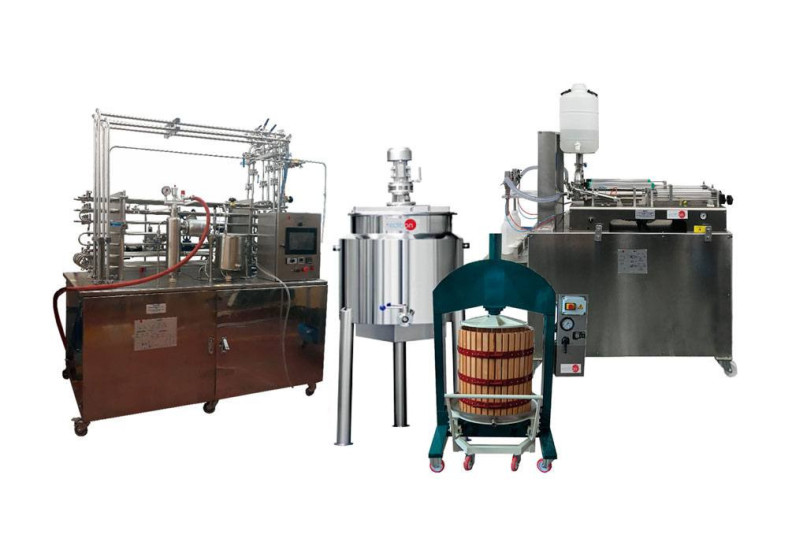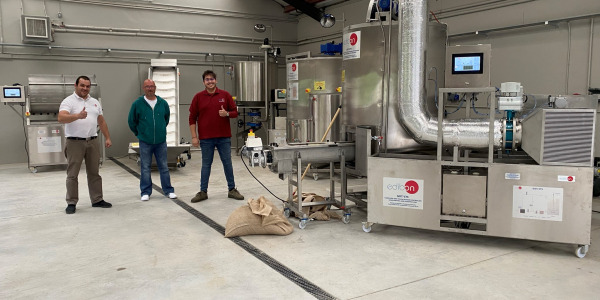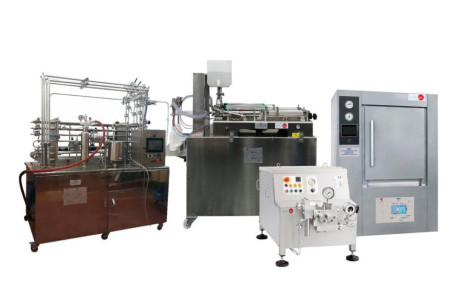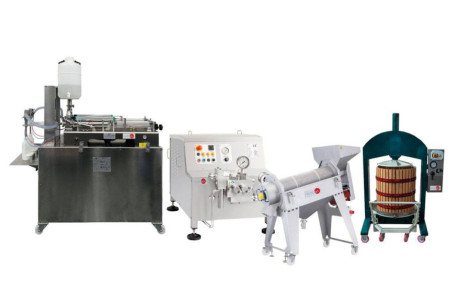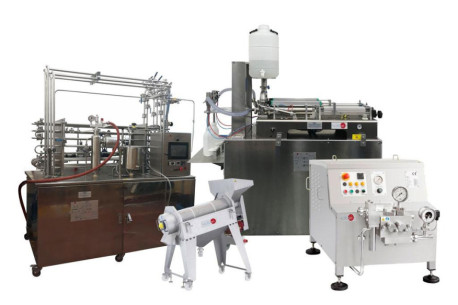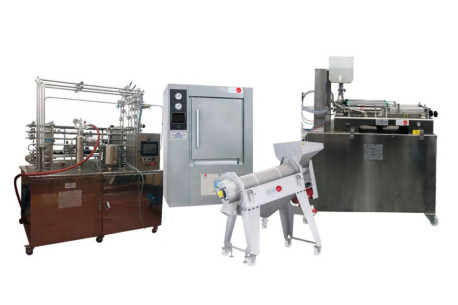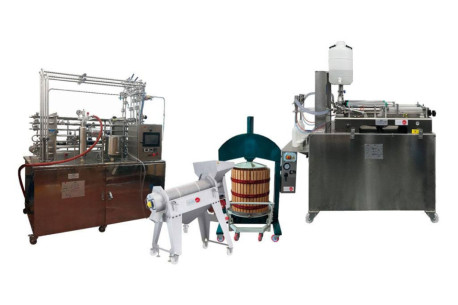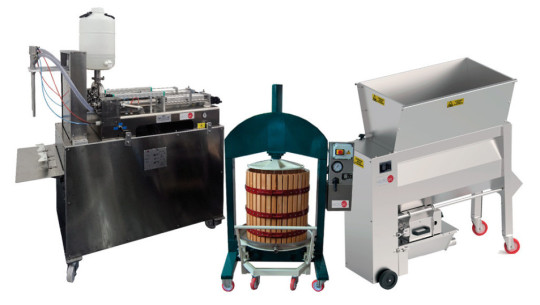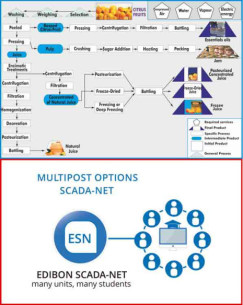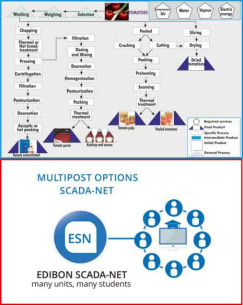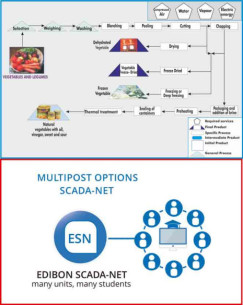The Pilot Plant for the production of pasteurized juice from fruits, "FR00/JP", is a scale size pilot-plant equipped to carry out all industrial stages of pasteurized juice production.
- WMFV. Washing Machine for Fruit and Vegetables. Fruit washing is essential to ensure hygiene and food safety. Its function is to remove any dirt, residue or surface contaminants from the fresh fruit, ensuring that it is clean and ready for processing. In addition, during this process, pieces of fruit that do not meet the quality standards for consumption are discarded. Once the selection is complete, the fruit is peeled if necessary, preparing it for the next step: juice extraction.
- FPCR. Fruit Pitting and Crushing Unit. This process involves pitting and crushing the fruit to obtain the juice efficiently, which represents a key role in the fruit preparation stage. It crushes the fruit and removes the pits and seeds from the fruit, which facilitates juice extraction and ensures greater efficiency in the process.
The next step in juice extraction is the pressing of the crushed fruit, where two alternative units are available: the Sheet Press for Liquid Products Extraction, "SPLE" and the Hydraulic Press for Liquid Product Extraction, "HPLE". In this way, the pilot plant includes one of the two pressing units mentioned above, depending on the type of pressing required:
- SPLE. Sheet Press for Liquid Products Extraction. The manual sheet press is used to separate the juice from the pulp and the solids from the crushed fruit. Its manual operation allows a more precise control of the process and is ideal for smaller production batches.
- HPLE. Hydraulic Press for Liquid Product Extraction. Another form of pressing is the hydraulic press, which is a larger and automated version of the manual press. It provides uniform and controlled pressure on the crushed fruit, which facilitates efficient juice extraction and effective solids separation. Pressing is a crucial step in separating the juice from the pulp and large fruit solids. The result is a liquid product free of large solid particles, along with the fruit pulp.
Once the fruit has been pressed, the product goes through an enzymatic process. This step is essential to ensure the proper preservation of the product, extending its shelf life and maintaining its freshness and natural flavor. For this step, the plant includes the following unit:
- TCAT. Temperature-Controlled Agri-food Tank. This unit is used to carry out enzymatic processes that help improve the quality and flavor of the juice. Temperature control ensures optimal conditions for enzymatic activity, allowing for greater efficiency in the transformation of fruit into juice. Subsequently, the extracted liquid must be clarified by using the following filter sheet.
- SFAF. Sheet Filter for Agri-food Liquid Products. The sheet filter is essential to remove any remaining solid residue from the juice, ensuring that the final product is clear and free of undesirable particles, which improves its appearance and organoleptic quality.
Once the fruit has been pressed, treated and filtered, the product goes through a pasteurization process, where two alternative units are available: the Computer Controlled and Touch Screen UHT Unit, "AUHT/CTS" and the Computer Controlled Teaching Autonomous Pasteurization Unit, "PADC". In this way, the pilot plant includes one pasteurization unit of the two mentioned previously, according to the needs of the process.
This step is essential to ensure the proper preservation of the product, extending its shelf life and maintaining its freshness and natural flavor. There are three different processes: VAT or slow pasteurization, High temperature short time pasteurization (HTST) and Ultra-High Temperature pasteurization (UHT).
- AUHT/CTS. Computer Controlled and Touch Screen UHT Unit. It is a compact design and easy installation pilot plant that works as independent unit or as part of an integrated process finishing that allows for studying in depth the UHT (at Ultra-High Temperature) pasteurization process of products and the variables of the process.
- PADC. Computer Controlled Teaching Autonomous Pasteurization Unit. An alternative to the previous pasteurization unit is the Computer Controlled Teaching Autonomous Pasteurization Unit, "PADC". Allows to study VAT or slow pasteurization and its process variables. The unit receives juice from a refrigeration tank (not included) and this is impelled with a pump (computer controlled). It is heated in the heat exchanger, by counter-current flow, with hot water coming from a circuit formed by a water tank with a heating element (computer controlled), a water pump (computer controlled), a manometer, a security valve, an expansion vessel, a purge valve and a pressure regulator, until reaching the established pasteurization temperature. Both pasteurizers are used to heat the juice to a temperature sufficient to eliminate harmful bacteria and microorganisms, without compromising the flavor and nutrients of the juice. This process helps to extend the shelf life of the product without significantly altering its properties.
The filtered and treated product is bottled using a bottling and capping machine. The plant has two alternative bottling machines: the Computer Controlled Liquid Packaging Teaching Unit, "EDLC" and the Bottling Machine for Agroalimentary Liquid Products, "BMAF". Therefore, the pilot plant includes one of the two bottling units mentioned above, as required.
- EDLC. Computer Controlled Liquid Packaging Teaching Unit. This unit allows the juices to be stored in containers suitable for transport and preservation, ensuring that they reach the final consumer with maximum quality and freshness. The Computer Controlled Liquid Packaging Teaching Unit, "EDLC", is a liquid and semi-dense products dosing machine based on dose delivery through a pneumatically-operated cylinder. The packer is responsible for filling the containers with the processed juice in an efficient and sanitary manner.
- BMAF. Bottling Machine for Agroalimentary Liquid Products. An alternative to the previous unit is the Bottling Machine for Agroalimentary Liquid Products, "BMAF". This unit can only dispense liquid products, compared to the possibility of packaging semi-dense products from the "EDLC". The bottling machine is crucial in the production line, since it is responsible for filling the containers with the processed juice in an efficient and sanitary way, ensuring the transportation and correct storage of the product.
Finally, the product is capped and sealed for its correct conservation in the following unit supplied:
- EDMT. Capping Machine for Agri-food Liquid Products. The capper is responsible for placing the hermetic caps on the juice-filled containers, ensuring that they are securely sealed and that the product is protected against contamination and oxidation. This unit together with the bottling machine ensures that the final product is ready for distribution and consumption, maintaining its freshness and quality.
Depending on the required production and the characteristics of the fruits to be treated there are recommended the following elements.
Additional recommended elements (Not included):
If a high product flow is required, the use of a transit pump to pump and transport the intermediate products from the plant is recommended. The following unit can be considered for this application:
- TPAF. Transit Pump for Agri-food Products. This unit can be used with a wide variety of agri-food products and allows working in a wide range of flow rates.
Finally, during the whole production process, products and by-products are generated and can be stored in steel (not included) or polypropylene (not included) tanks suitable for working with agri-food products. The units that perform this function are:
- SSTAF. Stainless Steel Tank for Agri-food Products. Stainless steel tank designed for the storage of intermediate and final products in a plant. Its stainless steel construction ensures corrosion resistance and a hygienic surface. Its modular design and storage capacity make it ideal for efficient management of production processes.
- PTAF. Polyethylene Tank for Agri-food Products. Polypropylene tank designed for the storage of intermediate and final products in an industrial plant. Its polypropylene construction offers resistance to chemical corrosion and excellent durability, making it ideal for environments where agri-food substances are handled. Its lightweight and versatile design allows for easy installation and transport.
 쿠키 기본 설정
쿠키 기본 설정

